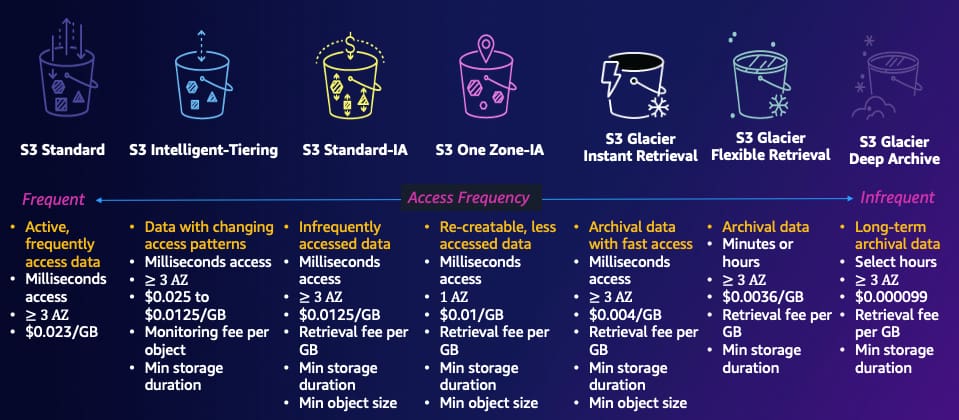
Amazon S3: Cloud Object Storage Solutions
Introduction
Ideal Use Cases
Storage Classes
Anti-Patterns
Performance
Amazon S3 Durability & Availability
Cost Model
Amazon S3 Scalability & Elasticity
Amazon S3 Interfaces
Conclusion
Introduction
Amazon S3 (Simple Storage Service) is a highly scalable, reliable, and secure cloud-based object storage service offered by Amazon Web Services (AWS). It provides a simple web services interface that enables you to store and retrieve any amount of data from anywhere on the web. In this article, we will discuss the benefits of Amazon S3 and how it can help you securely store and manage your data in the cloud.
We will also explore the different features and use cases of Amazon S3, such as website hosting, data archiving, and backup and recovery. With Amazon S3, you can scale your storage resources seamlessly and pay only for what you use, making it a cost-effective solution for businesses of all sizes.
Ideal Use Cases
Amazon S3 is an ideal storage service for many use cases. Here are some of them:
-
-
- Backup and Archiving: Amazon S3 provides a cost-effective and reliable solution for backing up and archiving data. With S3, you can store and retrieve any amount of data from anywhere in the world.
- Data Lakes: Amazon S3 is an ideal storage service for building data lakes. It can store any type of data, including structured, semi-structured, and unstructured data.
- Static Website Hosting: Amazon S3 can be used to host static websites, including HTML, CSS, and JavaScript files.
- Content Delivery: Amazon S3 can be used to store and deliver content, including videos, images, and documents. It can be used to deliver content to users around the world.
- Big Data Analytics: Amazon S3 is an ideal storage service for big data analytics. It can store massive amounts of data that can be processed using services like Amazon EMR (Elastic MapReduce).
-
Amazon S3 Storage Classes
Amazon S3 offers several storage classes, each designed for different use cases. Here are the storage classes:
-
-
Amazon S3 Standard:
-
This is the default storage class for Amazon S3. It offers high durability, availability, and performance. It is suitable for frequently accessed data.
2.S3 Intelligent-Tiering:
This storage class is designed for data with unknown or changing access patterns. It automatically moves data between two access tiers based on changing access patterns.
3. S3 Standard-Infrequent Access (S3 Standard-IA):
This storage class is designed for infrequently accessed data. It offers the same performance, durability, and availability as S3 Standard but at a lower cost.
4. Amazon S3 One Zone-Infrequent Access (S3 One Zone-IA):
This storage class is similar to S3 Standard-IA, but data is stored in a single availability zone. It is suitable for data that can be easily recreated.
5.S3 Glacier:
This storage class is designed for long-term storage of data that is rarely accessed. It offers the lowest cost but with longer retrieval times.
Amazon S3 Anti-Patterns
There are some anti-patterns that should be avoided when using Amazon S3. Here are some of them:
-
-
- Storing Temporary Files: Amazon S3 is not designed for storing temporary files. It is designed for storing data that needs to be accessed frequently.
- Using S3 for Databases: Amazon S3 is not a database. It is designed for storing files, not for storing structured data.
- Not Using Versioning: Amazon S3 offers versioning, which allows you to store multiple versions of an object. Not using versioning can result in data loss.
-
Amazon S3 Performance

Amazon S3 is designed for high performance. Here are some performance characteristics of Amazon S3:
-
-
- Low Latency: Amazon S3 offers low latency for retrieving data.
- High Throughput: Amazon S3 offers high throughput for transferring data.
- Scalability: Amazon S3 can scale to store any amount of data.
-
Amazon S3 Durability & Availability
Amazon S3 offers high durability and availability. Here are some durability and availability characteristics of Amazon S3:
-
- 99.999999999% Durability: Amazon S3 is designed to be highly durable. It offers 99.999999999999% durability for objects stored in S3.
-
- Multiple Availability Zones: Amazon S3 stores data across multiple availability zones, which provides high availability for data access.
- Replication: Amazon S3 offers cross-region replication, which automatically replicates data to a different region for disaster recovery.
Cost Model

Amazon S3 offers a flexible cost model. Here are some cost characteristics of Amazon S3:
-
-
- Pay-As-You-Go: Amazon S3 offers a pay-as-you-go pricing model, which means you only pay for what you use.
- No Minimum Fees: Amazon S3 does not have any minimum fees, which makes it cost-effective for storing small amounts of data.
- Cost Optimization: Amazon S3 offers tools for cost optimization, including lifecycle policies that automatically move data to lower-cost storage classes.
-
Amazon S3 Scalability & Elasticity
Amazon S3 is designed for scalability and elasticity. Here are some scalability and elasticity characteristics of Amazon S3:
-
-
- Scalability: Amazon S3 can scale to store any amount of data.
- Elasticity: Amazon S3 can automatically adjust its storage capacity based on changing demands.
- API Access: Amazon S3 offers API access, which makes it easy to integrate with other AWS services.
-
Amazon S3 Interfaces
Amazon S3 offers several interfaces for accessing and managing data. Here are some interfaces:
-
-
- AWS Management Console: The AWS Management Console is a web-based interface for managing Amazon S3.
- AWS CLI: The AWS Command Line Interface (CLI) is a command-line interface for managing Amazon S3.
- AWS SDKs: AWS SDKs are available for several programming languages, including Java, .NET, Python, and Ruby.
-
Conclusion
Amazon S3 is a flexible, scalable, and reliable storage service that offers several storage classes, high durability and availability, cost optimization tools, and API access. It is an ideal solution for backup and archiving, data lakes, static website hosting, content delivery, and big data analytics. By understanding its characteristics, storage classes, anti-patterns, performance, durability & availability, cost model, scalability & elasticity, and interfaces, you can leverage Amazon S3 to meet your storage needs efficiently and cost-effectively.
Further Readings





